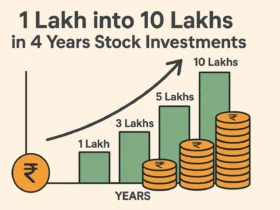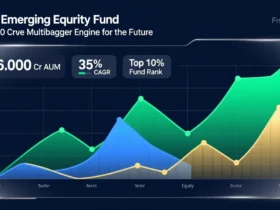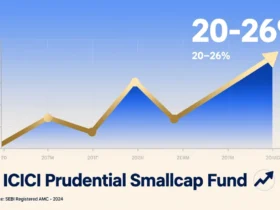You invest just $500 a month for 10 years, and with an average annual return of 8%, your money grows to over $90,000. That’s not a fantasy—it’s the magic of consistent investing and compound interest at work! Whether you’re dreaming of a comfortable retirement, funding your child’s education, or simply building wealth, the key lies in choosing the right investment option for your monthly contributions. In this ultimate guide, we’ll dive deep into three popular choices—mutual funds, Systematic Investment Plans (SIPs), and individual stocks—to help you decide where to invest for 10-year growth. Plus, we’ll offer insights on how to pick the best options and provide examples to get you started. Ready to unlock your financial future? Let’s get started!
Table of Contents
Why Invest Monthly for 10 Years?
Before we explore the options, let’s talk about why a 10-year horizon is a game-changer. Ten years is long enough to ride out market ups and downs, harness the power of compounding, and see substantial growth. According to historical data, the S&P 500 has delivered an average annual return of about 7-10% over the long term, adjusted for inflation. That’s why starting now and staying consistent can turn small monthly investments into a significant nest egg. So, where should you put your money? Let’s break it down.
Section 1: Understanding Mutual Funds
What Are Mutual Funds?
Mutual funds are like a financial buffet—they pool money from many investors to buy a diverse mix of stocks, bonds, or other securities. Managed by professional fund managers, these funds take the guesswork out of investing by spreading your money across various assets.

Types of Mutual Funds
- Equity Funds: These focus on stocks and aim for capital growth. They’re riskier but can offer higher returns—perfect for a 10-year goal.
- Debt Funds: Invest in bonds and fixed-income securities for steady, lower-risk returns.
- Hybrid Funds: A mix of stocks and bonds to balance risk and reward.
- Index Funds: These mimic a market index (like the S&P 500), offering broad exposure with low fees.
Pros and Cons of Mutual Funds
Pros:
- Diversification: Your money is spread across many securities, reducing risk.
- Professional Management: Experts handle the investing for you.
- Accessibility: Easy to buy through brokers or online platforms.
- Variety: Options for every risk level and goal.
Cons:
- Fees: Expense ratios (e.g., 0.5%-2%) can nibble at your returns.
- Limited Control: You don’t pick individual investments.
- Market Risk: Even diversified funds can dip during downturns.
How to Choose the Right Mutual Fund
Picking a mutual fund isn’t about chasing the hottest trend. Here’s what to consider:
- Goal Alignment: Does the fund match your growth objective?
- Risk Tolerance: Are you comfortable with its ups and downs?
- Past Performance: Look for consistency over 5-10 years, not just a lucky year.
- Expense Ratio: Lower fees mean more money stays in your pocket.
- Fund Manager: A seasoned manager can make a big difference.
For example, funds like the Vanguard 500 Index Fund have a stellar reputation for tracking the S&P 500 with minimal fees, making them a solid choice for long-term growth.
“In the long run, it’s not just how much money you make that will determine your future prosperity. It’s how much of that money you put to work by saving it and investing it.” – Peter Lynch
Section 2: Systematic Investment Plans (SIPs)
What Is a SIP?
A Systematic Investment Plan (SIP) is a smart way to invest in mutual funds. You commit to a fixed amount—say, ₹500 or $10—every month, and it’s automatically invested into your chosen fund. It’s like setting up a savings habit with growth potential!
Benefits of SIPs
- Rupee Cost Averaging: You buy more units when prices are low and fewer when they’re high, smoothing out market volatility.
- Discipline: Regular investing keeps you consistent, no matter the market mood.
- Low Entry Point: Start with small amounts, making it beginner-friendly.
- Compounding Power: Your returns earn returns over time, supercharging growth.
For instance, if you invest $100 monthly in a fund with an 8% annual return, after 10 years, you’d have around $17,500—over $5,500 of that is pure profit from compounding!
How to Start a SIP
- Pick a Fund: Choose one that fits your risk and growth goals (more on this later).
- Set Up Auto-Payments: Link your bank account for hassle-free investing.
- Decide the Amount: Start small or go big—your call!
- Review Regularly: Check in annually to ensure it’s on track.
Top Mutual Funds for SIPs
Here are some categories and examples of funds often praised for long-term SIP potential (based on historical trends, not guarantees):
- Large-Cap Funds: Axis Bluechip Fund—stable, blue-chip stock focus.
- Flexi-Cap Funds: Parag Parikh Flexi Cap Fund—adapts to market conditions.
- Small-Cap Funds: Quant Small Cap Fund—high growth, higher risk.
Disclaimer: Past performance doesn’t predict future results. Research thoroughly or consult an advisor.
Section 3: Investing in Stocks
What Are Stocks?
Stocks are shares of ownership in a company. Buy a stock, and you’re betting on that company’s success—think Apple, Tesla, or Amazon. It’s hands-on and can be rewarding, but it’s not without risks.
Pros and Cons of Stocks
Pros:
- High Returns: Stocks have historically outpaced other assets over decades.
- Dividends: Some companies pay you to hold their stock.
- Control: You pick exactly where your money goes.
Cons:
- Volatility: Prices can swing wildly day-to-day.
- Research Intensive: You need to study companies and markets.
- Risk: One bad apple can spoil your portfolio.
How to Choose Stocks for 10-Year Growth
Look for these qualities:
- Strong Fundamentals: Healthy profits, low debt, and steady revenue growth.
- Growth Sectors: Tech, healthcare, and renewable energy are hot for the next decade.
- Competitive Edge: Companies with unique products or market dominance.
- Reasonable Valuation: Avoid overpaying for hype.
Examples? Tech giants like Microsoft (cloud computing leader) or NextEra Energy (renewable energy pioneer) are often cited for their long-term potential.
“The stock market is designed to transfer money from the active to the patient.” – Warren Buffett

Section 4: Comparing Mutual Funds, SIPs, and Stocks
Which option suits your 10-year plan? Let’s compare:
| Factor | Mutual Funds | SIPs | Stocks |
|---|---|---|---|
| Risk | Moderate (depends on type) | Matches the fund’s risk | High, especially single stocks |
| Potential Returns | Good (5-12% avg. for equity) | Same as fund, boosted by averaging | Very high (10-15%+ possible) |
| Ease of Investment | Easy, managed for you | Super easy, automated | Requires active effort |
| Minimum Investment | Varies ($50-$1000) | As low as $10/month | One share (e.g., $50-$200) |
| 10-Year Fit | Great for diversification | Ideal for steady growth | Best for risk-takers |
Verdict: SIPs in equity mutual funds strike a sweet spot—growth potential, diversification, and simplicity. Stocks shine if you’re ready to roll up your sleeves.
Section 5: Specific Recommendations
While I can’t offer personalized advice, here’s how to approach your choices, with examples to inspire you.
Mutual Funds for SIPs
Focus on these types:
- Large-Cap Funds: Stability with growth (e.g., Axis Bluechip Fund).
- Index Funds: Low-cost market tracking (e.g., Vanguard 500 Index Fund).
- Mid/Small-Cap Funds: Higher risk, higher reward (e.g., Nippon India Small Cap Fund).
Why These? They’ve shown resilience and growth over long periods, per historical data.
Stocks for Long-Term Growth
Consider these sectors and examples:
- Technology: Apple (innovation leader), Microsoft (cloud dominance).
- Healthcare: Johnson & Johnson (diverse, stable).
- Green Energy: Tesla (EV pioneer), NextEra Energy (renewables).
Why These? Strong fundamentals and future-ready industries. Diversify—don’t bet on just one!
Disclaimer: These are examples, not buy orders. Always research or consult a pro.
Section 6: Tips for Successful Investing
- Diversify: Don’t put all your eggs in one basket—mix funds, stocks, or sectors.
- Stay the Course: Resist panic-selling during dips; 10 years smooths volatility.
- Review Annually: Tweak your portfolio as goals or markets shift.
- Start Early: The sooner you begin, the more compounding works for you.
Here’s a quick growth example:
| Monthly Investment | Years | Annual Return | Total Value |
|---|---|---|---|
| $100 | 10 | 8% | $17,500 |
| $500 | 10 | 8% | $87,500 |
Small steps lead to big wins!
FAQs
Q: What’s the minimum amount to start a SIP?
A: As little as ₹500 or $10 monthly, depending on the fund—perfect for beginners!
Q: Can I lose money in mutual funds?
A: Yes, especially short-term. But over 10 years, diversification and growth often offset losses.
Q: Mutual funds or stocks—which is better?
A: Mutual funds for ease and diversification; stocks for higher returns with more effort.
Q: Are there tax benefits?
A: In some countries, long-term gains (over 1 year) get favorable tax rates. Check local laws!
Conclusion
Your 10-year growth journey starts with a choice: mutual funds for diversification, SIPs for discipline, or stocks for bold returns. For most, SIPs in equity mutual funds offer the best blend of growth, simplicity, and peace of mind. Stocks can turbocharge your portfolio if you’re up for the challenge. Whatever you pick, diversify, stay patient, and start today. Your future self will thank you! Got questions or tips? Drop a comment below—I’d love to hear from you!
































Leave a Reply